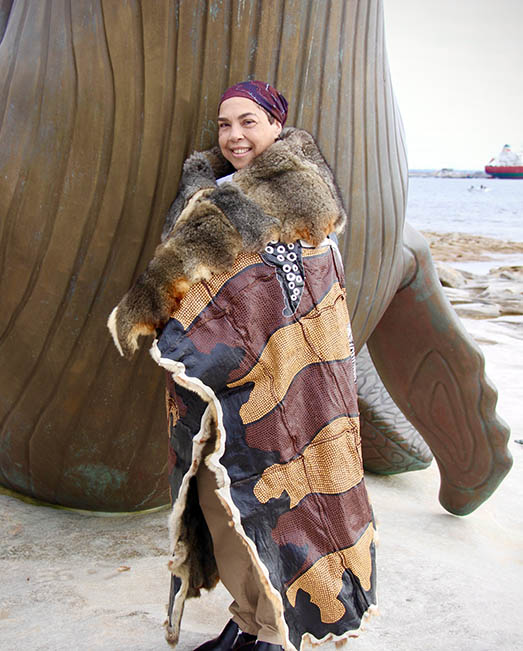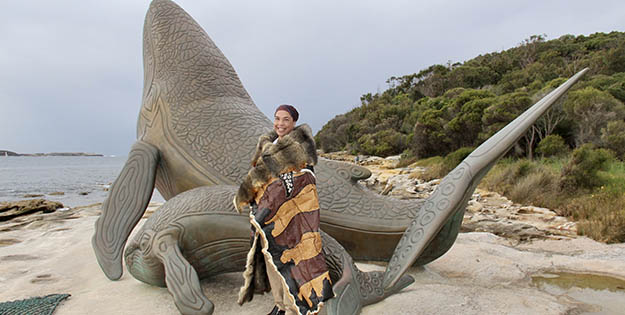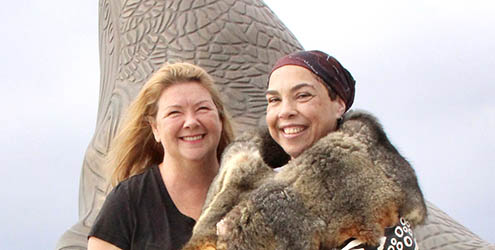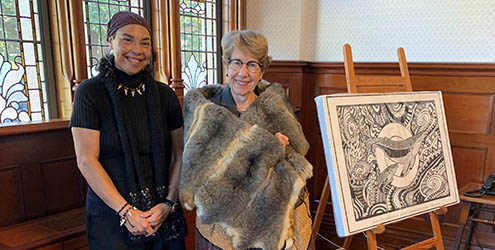Community
Copyright@ Australian Catholic University 1998-2026 | ABN 15 050 192 660 CRICOS registered provider: 00004G | PRV12008
Copyright@ Australian Catholic University 1998-2026 | ABN 15 050 192 660 CRICOS registered provider: 00004G | PRV12008

It’s a public holiday in mid-June and scores of visitors have come to Kamay Botany Bay to see Wi-Yanga and Gurung, the spectacular bronze whales installed for the 250th anniversary of the encounter between the Gweagal and the crew of the Endeavour.
“These are my whales,” says Theresa Ardler, who created the original design of the humpback mother and calf, sculpted by Newcastle artist Julie Squires. “They tell the story of my spiritual ancestors, and how we came from the ocean onto the land.”
The visitors turn their attention to Theresa as she unfurls her budbili — the stunning possum skin cloak she wore during her graduation ceremony in 2019, when she completed her Master of Religious Education at ACU.
On the front of the cloak is her painting of Wi-Yanga and Gurung, based on the rock engravings of a mother humpback and baby at Guriwal La Perouse, on Theresa’s ancestral homeland. While Ardler was raised amongst her father’s Wandandian people in the Wreck Bay Aboriginal community, she was born in Sydney and has familial connections to the Gweagal and Bidjigal clans.
“I’ve been taken to visit that rock engraving at ‘Lapa’ since I was a child, with my mum and my grandmother, who were both raised in the La Perouse Aboriginal community,” she says.

“That engraving is a prominent landmark for my ancestors, who carved the rock. The humpback whale is our totem, and it continues to hold that cultural and spiritual connection to sea and country, and these sculptures here represent and honour that connection and our ancestors.”
What actually happened when those ancestors spotted the Endeavour off the shores of Kamay remains contested.
On the 250th anniversary of the encounter, in April 2020, Prime Minister Scott Morrison acknowledged that Lieutenant James Cook’s arrival had “changed the course of our land forever”.
“It was an uneasy encounter,” said Mr Morrison, whose electorate takes in the southern part of Botany Bay and is named after Cook.
The Gweagal people were “surely threatened by Cook’s presence”, the Prime Minister said, and the legacy of his arrival “indeed resulted in their loss of country, language and culture”.
In a written statement, he added: “These stunning new installations at Kurnell capture the view from the ship and the view from the shore in a magnificent way. They will stand for generations to come and enable us to reflect upon our unique and shared history.”
As a result of the pandemic, a series of events planned to mark the 250th anniversary of Cook’s landing were cancelled, including the official unveiling of the new sculptures.
For many Aboriginal and Torres Strait Islander people, this came with a sense of relief.
“For many years on that anniversary, they would do a re-enactment of Cook’s first contact with the Aboriginal people, and my people and I, we just got really sick of that,” Theresa says. “We wanted something that got away from that first encounter, because it still feels really raw for my people.”
The rawness comes partly from the fact that the events that took place in 1770 and the decades that followed are still a matter of confusion and contention.
While the myth that Cook “discovered” Australia has long been debunked, many Aboriginal and Torres Strait Islander people remember it being taught in schools.

“The history books said Cook discovered Australia, as if there weren’t people here when he arrived,” Theresa Ardler says. “For a very long time in Australian history, we didn’t exist as traditional owners and weren’t even recognised as citizens, and it makes me deeply sad to reflect on that.”
As for what happened when Cook and his men approached the locals at Kamay, Theresa says the oral history passed down by her elders also differed to the textbooks.
“When I was at high school, I remember reading a textbook saying that Cook’s men fired shots but they missed the locals, that the bullets went over their heads,” explains Theresa, who says she’s a direct descendent of a warrior named Cooman, one of two Gweagal men said to have confronted the explorers.
“I stood up in class and said, ‘That is so wrong, because those shots were fired into them, and my ancestor Cooman was hit in the leg. Rip that page out of the history book because it needs to be rewritten’.”
Possible physical evidence of this conflict, a bark shield with what appears to be two bullet holes, still sits in the British Museum, but the La Perouse community has long been engaged in a campaign to have it returned to Australia.
Theresa first saw the shield in 2016 when it was on display at the National Museum of Australia in Canberra as part of its Encounters exhibition.

Theresa and her collaborator Julie Squires
“It was just mind-blowing and emotional to see the shield in front of you, and that’s why I think it’s very important that the shield comes back to this country,” she says.
“It’s part of our story and our stories are important to us. I come from a long line of artists and storytellers, and it’s our stories that help us to heal country, and help us to understand the strong nature of our culture and what’s important to pass on.”
Theresa and her collaborator Julie Squires have been heartened by the enthusiastic response to the whale sculptures, despite the fact they were installed with little fanfare or publicity.
“It’s a beautiful image, the image of mother and baby, and everyone who sees it tends to have a strong connection to it,” says Julie, who has been collaborating with Indigenous artists since 1993.
“It just seems to resonate with everyone — children and their grandparents, people from different cultures and nationalities — it’s a piece of art that transcends cultures and age groups, and I think the unifying aspect of it makes people realise that we’re all part of this together.”
Among its fans is the NSW Governor, Her Excellency Margaret Beazley, who first met Theresa Ardler at a ceremony to celebrate the awarding of ACU’s honorary doctorate to the Governor in 2019. Theresa delivered the Welcome to Country in language on that occasion, and on a later meeting with the Governor, she wore her budbili, which caught the eye of Ms Beazley.
“I met with Governor Beazley again in May and took my possum skin cloak with me, and when she heard about the sculptures, she said, ‘I’d like to come and see your whales’,” Theresa says.

Theresa and NSW Governor, Her Excellency Margaret Beazley.
On 8 July 2021, Ms Beazley will officiate an event on the site of the whale sculptures during NAIDOC Week, which this year has the theme “Heal country, heal our nation”.
Julie Squires says she hopes the new artworks installed on the shores of Kamay Botany Bay will help Australians to reflect on our history.
“Public art shouldn’t just be a white Australian story, it should be a shared story,” she says.
“This is Theresa’s story, it’s the story of her people, and the two of us have come together to make something that acknowledges and celebrates the Gweagal community, and the Aboriginal people who were here long before Cook was.”
Theresa, meanwhile, has a positive view of the future for First Nations people. She believes many more non-Indigenous Australians are now willing to shift their lens, and “see things from the view of the traditional owners”.
“These whales here represent the view my ancestors had from the shore, looking out to sea, and it allows other people to see that point of view,” she says.
“These pieces of public art provide an opportunity for the traditional owners to be recognised and to have a voice. It’s time to bring our stories and our culture back into play, because they’ve always been here — they’ve never gone away.”
Theresa Ardler is the Director of Gweagal Cultural Connections, a business that educates school and university communities about the richness of Aboriginal culture and spirituality. She holds a Master of Religious Education and a Bachelor of Education from ACU, and is currently engaged in postgraduate study at Charles Darwin University.
Copyright@ Australian Catholic University 1998-2026 | ABN 15 050 192 660 CRICOS registered provider: 00004G | PRV12008